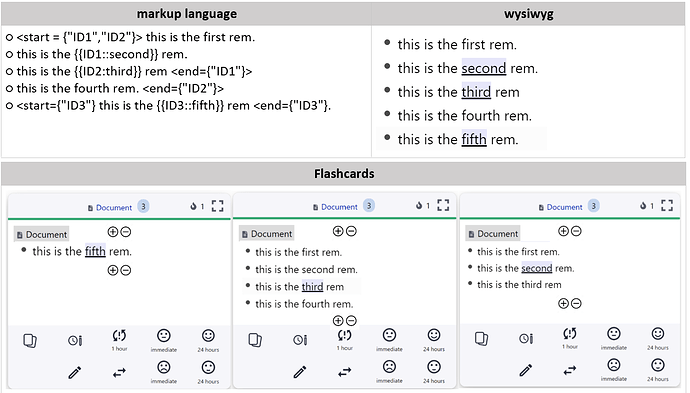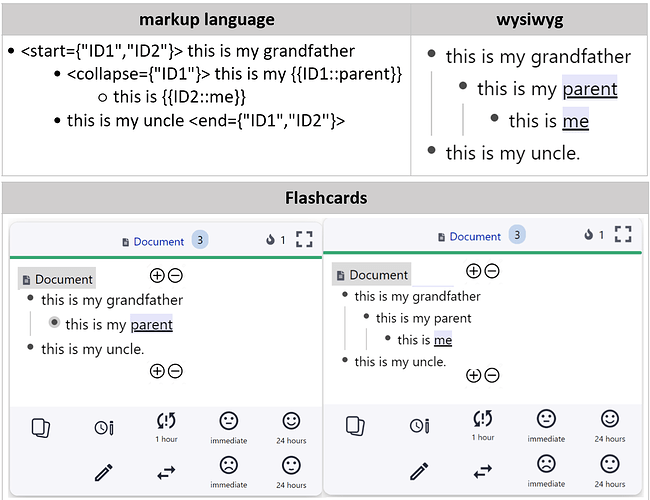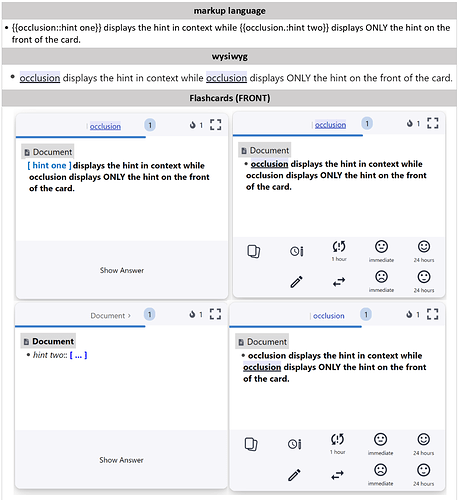TLDR: I have been thinking for some time in a flexible, powerful and simple system so that each user can personalize the flashcards to their liking. It is based on five functions: 1) each flashcard remembers which is the first and the last rem shown. 2) each flashcard remembers which rems are collapsed and which ones are open. 3) each flashcard (or occlusion) has a field called hint, which can be displayed only on the front of the card, or displayed together with its context. 4) Each flashcard remembers if all other occlusions should be hidden. 5) Different occlusions (even of different rems) can be combined into a single queue
UPDATE: Currently the development team has told me that Remnote does not store text with markup language, but as a graph of rems, so the implementations suggested in markup languages should be considered only complementary to the main intention of the article, which is to suggest the “what”. Developers will better decide the “how”.
1. each flashcard remembers which is the first and the last rem shown.
-
Explanation/description:
When reviewing flaschards there are two buttons + and - at the top, and likewise two buttons + and - at the bottom. Pressing them adds or removes a top or bottom rem respectively. -
Implementation:
For each {{occlusion}} there must be a rem with a tag indicating it is the first rem, and another with a tag indicating it is the last. In the following example the “start” and “end” tags contain as a parameter a list of all the occlusions that start and end with that rem respectively. -
Example:
2. each flashcard remembers which rems are collapsed and which ones are open.
-
Explanation/description:
When reviewing flashcards, subrems may collapse. Every time a card is studied, the program remembers or stores this information. -
Implementation:
As the most normal thing is that when checking cards the rems are not collapsed, only one markup tag is needed for each collapsed rem. In the following example the “collapse” tag contains as a parameter a list of all the occlusions in which the children of that rem are collapsed. -
Example:
3. each flashcard (or occlusion) has a field called hint, which can be displayed only on the front of the card, or displayed together with its context.
-
Explanation/description:
As in anki, it should be possible to add hints to occlusions. But not only that, perhaps one wants to make a kind of basic card where the back is a part of our rems but the front is a personalized question; Either because the context is not the best “input” to test our memory about that element of knowledge, or because the context somehow sabotages the answer. See about it here and here. -
Implementation and example:
CLARIFICATION: the clue that follows the notation .: Must also be shown on the back of the card. The bottom right flashcard in the image should contain “hint two” at the top.
4. Each flashcard remembers if all other occlusions should be hidden.
-
Explanation/description:
When the queues are being reviewed, there should be a button / option to toggle between “hide other occlusions” or show them. Then, all {{occlusions}} that are between the first and last rem (see point 1), must also be hidden.
5. Different occlusions (even of different rems) can be combined into a single queue.
-
Explanation/description:
Currently, occlusions can only be combined if they belong to the same rem. It is easy to think about how this restriction could be eliminated with the first and last rems parameters described in point 1. They could be combined using the anki notation. The null value can be allowed as no combination. -
Example:
• {{c1::this occlusion}} is combined with that of the third rem
• this occlusion is not {{combined}}
• this occlusion is combined with that of the first {{c1::rem}}. -
Clarifications:
• The “c” fields should not be confused with the IDs mentioned in points 1 and 2. The c fields are typed by the user to combine different occlusions while the IDs are those generated by Remnote and the user never actually sees them.
• In each queue, the display hides all the occlusions with the same “c” field inside the first and last tags. For this reason, there is no need to worry about other occlusions with the same c field in other parts of the document.
Final words
In the introduction I said that this system is “flexible, powerful and simple”. But there is an even more important reason to incorporate it.
According to the documentation,
RemNote is built by Anki users who felt constrained by Anki’s" question: answer "format. Instead of cramming all knowledge into question-answer blocks, RemNote lets you represent knowledge in the same way it’s structured in your brain.
Clearly, remnote can only really achieve its goal with a system like the one described in this article. Yes, remnote allows you to organize the flashcards in an infinite outliner much more organized than anki, but we are still tied in a sense to the question-answer format.
For such a radical paradigm shift, a way to combine the best of cloze occlusions with fields is also necessary. Only then can we represent knowledge in the same way it’s structured in our brains




